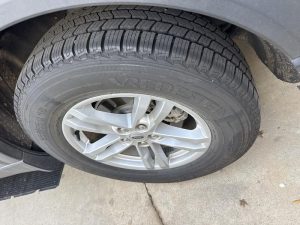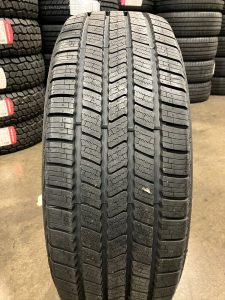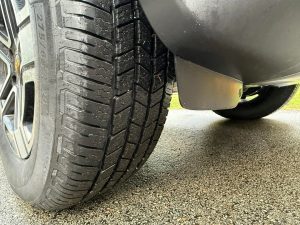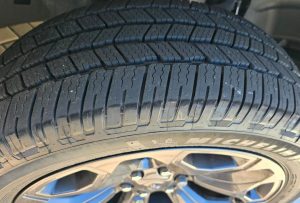The Vredestein Pinza HT is the highway all-season tire from Vredestein, built for trucks and SUVs that live most of their life on the road. Its sibling, the Pinza AT, is already pretty popular among SUV and CUV owners. Well, that makes sense — people like me usually lean toward the more aggressive stuff. The internet is packed with reviews and feedback for the Pinza AT, but when it comes to the HT version, things get quieter. That’s surprising, because there are a lot of drivers out there who prefer a tire made for daily highway use over occasional off-roading.
The problem is, their options are often limited. Most highway tires sit in the premium range — Michelin Defender LTX MS2, Continental TerrainContact H/T — great tires, but not everyone wants to pay top dollar. That’s where the Pinza HT comes in. In this article, I’ll take a close look at what this tire can actually do, compare it with those big names, and also benchmark it against its all-terrain sibling, the Pinza AT, for anyone thinking about going a bit more aggressive. You’ll see real test data, customer feedback from forums, and a few engineering insights from my side. Let’s dive in.
Quick Look
The Vredestein Pinza HT is a strong option, especially when it comes to value for money. It’s a solid competitor to premium tires like the Michelin Defender LTX M/S2 and Continental TerrainContact H/T. Test data shows it’s only about 2–3 feet behind those in stopping distance and feels just as stable when cornering.
Vredestein Pinza HT

It wears evenly, stays quiet, and holds up great over long miles. The only drawback is winter — it’s fine for light snow, but not built for harsh conditions. Still, for the price, the tread life and comfort make it one of the best highway tires you can pick right now.
Best Use Cases
Trucks and SUVs mostly driven on the highway
Drivers looking for comfort and long tread life
Towing or hauling light loads
Mild climates with occasional rain or light snow
Dry Grip and Handling — Pinza HT Tightens the Feel Without Losing Comfort
The Vredestein Pinza HT came out surprisingly strong in dry testing. It stopped from 60 mph in 138 feet and recorded an average cornering grip of 0.73 g, which puts it right in the top tier for highway-all-season tires. That much traction tells me the compound and tread structure are dialed in for road use—the tire resists squirming and stays composed in quick transitions. Behind the wheel, that usually means clean steering feedback and less body motion under load.
When you look at the data next to the big names, it holds its ground. The Michelin Defender LTX M/S2 stopped at 140 feet with 0.75 g, and the Continental TerrainContact H/T came in stronger with 130 feet and 0.76 g. Continental’s higher g-force and shorter braking distance show why it’s considered a premium reference in this segment. But still, the Pinza HT’s numbers are closer than you’d expect from a tire that costs significantly less. It stays predictable and steady through corners, and you don’t feel that wandering feedback you get from softer compounds. From an engineering perspective, that 0.73 g grip is a sweet spot—it’s balanced between comfort and control.
When we bring the Pinza AT into the picture, things make sense right away. The AT takes a few feet longer to stop (around 142 feet) and shows a bit less lateral grip (about 0.71 g), which is totally expected given its deeper tread and larger void area. Still, the difference between these two is smaller than I expected. The HT just tightens everything up a bit for the road without losing the composed ride the AT already had.
A few real-world comments back this up nicely. One Reddit user running Pinza ATs on his F-150 said they’re “quiet and ride good,” which shows how well Vredestein nailed the base tuning. On BobIsTheOilGuy, another driver noted the HT “compares very favorably to the Defender LTX M/S,” proving how close it gets to premium-tier refinement. And a truck owner on Facebook mentioned switching to the Pinza HT after poor mileage from his OEM tires — seeing it as a true highway upgrade, not a compromise.
Overall, the Pinza HT feels like a well-engineered balance — better grip and braking than its AT sibling, and performance that edges close to the big names without the price tag. If you spend nearly all your time on pavement, it’s one of those “set it and forget it” tires that just makes the truck feel right.
The Vredestein Pinza HT shows well-balanced results in wet testing. It stopped from 50 mph in 100 feet and completed the wet lap in 36.57 seconds, with an overall score of 6.50/10 in Tire Rack’s benchmark group. Those numbers place it solidly mid-pack, which makes sense given its highway-oriented compound. In real terms, that means it clears water effectively through its circumferential grooves while maintaining consistent grip during steering transitions. Even under heavier loads, the tire holds its line with minimal hydroplane tendencies — a sign of solid tread design and rubber stiffness balance.
Compared to the Michelin Defender LTX M/S2, which stopped in 100 feet as well but edged slightly higher in cornering feedback, the difference is subtle. The Continental TerrainContact H/T leads this group with a 97-foot stop and 7.06 overall score, showing Continental’s clear advantage in silica-blend compounds and tread geometry optimization. Still, the Pinza HT’s results are respectable, especially when factoring in its smoother ride and lower cost. It might not have Continental’s razor-sharp wet steering feel, but it’s predictable and steady when conditions turn ugly.
When compared to its sibling, the Pinza AT, things get interesting. The AT stopped at 103 feet and showed slightly more tread movement through the slalom, which is normal for a tire with larger voids. That puts the HT roughly 3 feet shorter in braking and noticeably more composed mid-corner. The closed shoulder ribs on the HT clearly help evacuate water while keeping the tread surface stable, resulting in fewer small slides when pushing through deeper puddles.
A few driver comments back this up. One Reddit user who switched from all-terrains to the Pinza HT said, “It’s been pouring this week and I’ve got zero hydroplane issues — these things feel planted.” On BobIsTheOilGuy, another mentioned, “They’re not flashy, but wet grip is confidence-inspiring. I expected less for the price.” That sums it up perfectly: steady, confidence-building traction without surprises.
Overall, the Pinza HT is tuned for predictability rather than sharp feedback in the rain. It’s the kind of tire that keeps you calm on wet highways, handles standing water confidently, and feels composed when braking with a load behind you — exactly what you want from a highway-focused all-season tire.
Winter and Light Snow Performance — Pinza HT Trades Bite for Balance
On snow and ice, the Vredestein Pinza HT delivers what I’d call “good enough” performance for a highway all-season. In testing, it completed the snow lap in 71.13 seconds, needed 83 feet for snow acceleration, and stopped from 25 mph in 81 feet. On ice, it stopped in 104 feet — not bad, but clearly aimed at mild winter use rather than deep, repeated freeze cycles. These numbers place it right in the middle of the test group, scoring a 6.25/10 overall. That’s what you expect from a tire built for road comfort first, traction second.
Compared to the Michelin Defender LTX M/S2, which stopped in 82 feet on snow and 105 feet on ice, the difference is negligible. The Michelin holds a slight edge in feel due to its softer tread and better compound temperature adaptability, while the Pinza HT stays firmer and more stable in mixed slush or melted conditions. The Continental TerrainContact H/T, however, still sets the standard here with a 77-foot snow stop and 95-foot ice stop, showing the benefit of a tread designed specifically for cold-weather flexibility.
When we look at the Pinza AT, it’s obvious where the trade-off lands. The AT version has more open shoulders and deeper sipes, giving it extra bite on packed snow. It stops around 78 feet on snow and 101 feet on ice, slightly ahead of the HT. That difference makes sense — larger voids clear snow faster and allow more edges to bite. But the HT counters with better braking consistency on plowed roads and doesn’t feel as vague when temperatures rise again.
A few online comments line up with these results. One Reddit user noted, “Handles light snow fine, but once you get into slush or deeper stuff, traction drops fast.” On Tire Rack, another reviewer mentioned, “No problem in winter rain or dusting snow, but I swap to dedicated winters once it gets icy.” That reflects exactly what I’d recommend too — it’s dependable for mild winters, but if you live where the snow piles up, a dedicated 3PMSF tire is still the smarter call.
Overall, the Pinza HT handles winter in a composed, balanced way. It doesn’t chase aggressive snow grip, but it stays consistent across varying road surfaces. For southern and coastal regions where winter means rain and light snow rather than ice storms, it’s more than capable.
Comfort is one of the Vredestein Pinza HT’s strongest suits. In testing, it scored an overall comfort rating of 7.25/10, with a 7.50 noise score and 7.25 ride score — placing it right behind top-tier tires like the Michelin Defender LTX M/S2 (8.25 overall) and Continental TerrainContact H/T (8.50 overall). That’s impressive for a tire that costs far less. On the road, that means you’ll feel fewer vibrations through the cabin and hear less tread hum, even at highway speeds.
The difference mostly comes from the tread design. The HT uses smaller, closely spaced center blocks that contact the road more frequently, which breaks up air pulses that typically create noise. The Michelin still wins in refinement thanks to its softer compound and dual-pitch patterning, while Continental’s higher stability score comes from a stiffer carcass that favors load-bearing applications. But the Pinza HT manages to sit right in the middle — steady and smooth without feeling overly soft or heavy.
Compared to its sibling, the Pinza AT, the ride quality difference is immediate. The AT has more open shoulders and deeper tread voids, which naturally produce more vibration and hum at higher speeds. The HT feels calmer on the highway and more controlled over uneven pavement. During quick transitions or small impacts, it absorbs bumps cleanly rather than echoing them through the suspension.
A few user comments highlight this difference well. On Reddit, one driver wrote, “My truck rides smoother with the HTs than it ever did with the stock Goodyears. You barely hear them on the freeway.” On Tire Rack, another reviewer mentioned, “Super quiet tire for a half-ton pickup. No drone, even on concrete.” That kind of feedback lines up exactly with the test data — quiet, confident, and stable.
Overall, the Pinza HT nails the balance between firmness and comfort. It’s tuned just right for daily drivers and highway commuters who want peace and smoothness without feeling detached from the road. Whether you’re driving empty or towing light loads, it stays composed and quiet — the kind of tire that fades into the background in the best way possible.
Treadwear and Durability — Real Mileage Reports and Warranty Insights
The Vredestein Pinza HT sits in the middle ground of the highway all-season category when it comes to warranty coverage. It’s rated for 8 years from production / 70,000 miles for P-metric sizes and 50,000 miles for LT sizes. That’s roughly on par with Michelin’s Defender LTX M/S2 (6 years / 75,000 miles for H- and T-speed, 50,000 for S) and Continental’s TerrainContact H/T (6 years / 70,000 Euro-metric, 60,000 LT). In other words, Vredestein is backing its highway lineup with premium-tier mileage expectations at a mid-tier price.
What really matters, though, is what drivers say. On Tire Rack, several owners mention the Pinza HT holding tread depth evenly past 20,000 miles, often using phrases like “still looks new” or “wears slower than my last Goodyears.” One Reddit user summed it up simply: “After about 15k miles, they’ve barely worn and still ride quiet.” Over on BobIsTheOilGuy, another comment read, “We’ve had great luck with Vredestein wear life — they harden evenly instead of chunking like cheaper brands.” That even-wear behavior usually signals a stable compound and consistent carcass tension — exactly what I’d expect from a company that leans on European touring-tire engineering.
Compared to the Pinza AT, the HT clearly focuses on smoother wear for highway use. The AT’s open shoulders and deeper voids make it more prone to cupping if you skip rotations, while the HT’s flatter rib pattern distributes pressure more evenly. For long-haul drivers or light-duty work trucks, that means fewer vibrations and quieter miles down the line.
In short, treadwear consistency seems to be a strong point for the Pinza HT. It may not outlast a Michelin in the most extreme duty cycles, but real-world owners keep reporting slow, predictable wear that aligns with its 70k-mile promise — and that’s all you can really ask from a highway tire built to cruise thousands of miles without fuss.
After going through the data, comparisons, and what real drivers are saying, I think the Vredestein Pinza HT easily earns its spot among the best mid-priced highway tires. It may not have the prestige of Michelin or Continental, but the numbers and feedback tell the story — consistent grip, quiet comfort, balanced wet stability, and slow, even wear. It’s not trying to be sporty or aggressive; it’s trying to make your truck feel composed and dependable every single mile, and it does that really well.
The Pinza AT will still be the better choice if you regularly see dirt or gravel, but for anyone spending 90% of their time on pavement, the HT feels like a smart upgrade. It closes the gap to premium brands without the premium bill.
Best Use Cases
Daily-driven trucks & SUVs: Excellent for highway and city use with smooth, quiet road manners.
Towing & light hauling: Stable carcass and predictable load behavior make it a confident match for work trucks.
Mild climates: Reliable year-round traction for southern or coastal regions where winter means rain, not blizzards.
Budget-conscious drivers: Offers premium-like ride and durability for far less than top-tier brands.
FAQ – Vredestein Pinza HT
Is the Vredestein Pinza HT a good alternative to Michelin and Continental?
Yes. Pinza HT runs very close to Michelin Defender LTX M/S2 and Continental TerrainContact H/T in on-road grip and stability. In dry stops it trails the premium pair by about 2–3 feet, which is a small gap for the price difference.
How does the Pinza HT feel on dry pavement?
Steady and predictable. It delivers clean steering, holds a line well through ramps, and resists tread squirm. Think calm highway manners with enough grip to feel confident under load.
How is it in the rain?
Balanced and easy to trust. The tread clears water well and the tire stays composed during quick lane changes and hard braking. It is tuned for predictability rather than sharp, sporty feedback.
Can I use Pinza HT in winter?
It handles light snow and cold rain fine, but it is not a harsh-winter or deep-snow tire. If you see frequent ice or heavy snow, a dedicated 3PMSF winter tire is the smarter pick.
How does treadwear look in real use?
Owner feedback is positive. Drivers report even wear, quiet running, and slow mileage loss when rotations are kept on schedule. It is a strong value play for long highway miles.
Is the Pinza HT good for towing or light hauling?
Yes. It keeps its shape under load and feels stable on the highway. Match the right load rating for your vehicle and keep rotations regular for the best results.
Should I choose HT or the Pinza AT?
If you stay on pavement most of the time, choose Pinza HT for quieter ride and shorter stops. If you want more loose-surface bite and a tougher look, choose Pinza AT.












